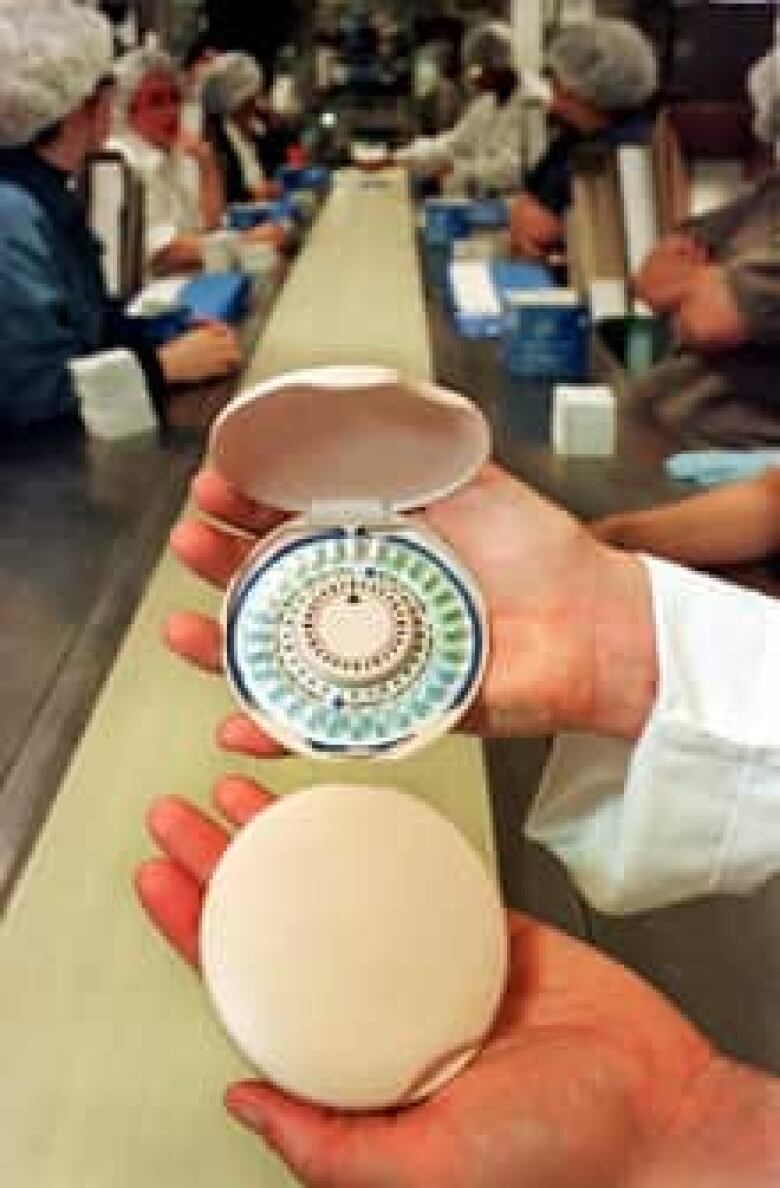The options for pregnancy prevention
It wasn't that long ago that it was illegal to buy or sell contraceptives. When the first birth control pills hit the Canadian market in 1961, they could only be prescribed to regulate the menstrual cycle.
That changed in 1969, when the federal government legalized birth control. That allowed condoms to come out from under drug store counters, where they had been sold to customers that asked specifically for them.
For men who have not undergone a vasectomy, the condom has remained the only effective option to avoid impregnating sexual partners. But it's more often marketed as the best protection against the spread of sexually transmitted infections.
For women, there has been an explosion in choice of birth control options.
Pills

Combination pills prevent ovulation, or the releasing of eggs by the ovaries. Progestin pills usually work by thickening cervical mucus, which prevents sperm from joining with an egg.
Oral contraceptives when used correctly are 97-99 per cent effective in preventing pregnancy. They do not protect against sexually transmitted infections.
Oral contraceptives may not be an option for all women. You'll need to be assessed by a doctor before you can get a prescription for them. Women on the pill face a slightly greater chance of developing blood clots in the legs, lungs, heart or brain.
Women over the age of 35 and women who smoke could face a greater risk of blood clots, heart attack or stroke.
There can also be side-effects related to oral contraceptives. They can include:
- Bleeding between periods.
- Weight gain or loss.
- Breast tenderness.
- Nausea and sometimes vomiting.
- Depression.
Birth control pills can also offer some health benefits, including some protection against:
- Ovarian cysts.
- Cancer of the ovaries.
- Cancer of the lining of the uterus.
- Menstrual cramps.
Most birth control pills keep women on a 28-day cycle between periods. There are some pills that suppress menstruation. Seasonale extends the time between periods so you have only four a year. However, there is greater chance of spotting or breakthrough bleeding (bleeding between periods) than with a traditional pill.
Lybrel was approved by the U.S. Food and Drug Administration in May 2007 as the first continuous use birth control pill. Women on the medication do not menstruate.
Proponents of the medication say halting menstruation means women no longer have to endure symptoms such as bloating, cramping, irritability, headaches and tender breasts associated with periods. Its maker says halting periods may also be an effective treatment for endometriosis, anemia and epilepsy.
Femcon Fe which was approved for sale in 2006 is a traditional birth control pill but is the first chewable oral contraceptive. It was designed for women who don't like to swallow pills.
Diane-35 is an acne drug that also prevents conception. However, Health Canada issued a warning in 2005 after five deaths and 35 cases of blood clots were linked to the drug. Health Canada says the drug should not be promoted or used as a method of birth control. It can be used to treat severe acne.
Plan B known as the "morning after pill" prevents pregnancy by preventing embryos from attaching to the wall of the uterus. It is considered 95 per cent effective if taken within 24 hours of unprotected sex. It has no effect on an established pregnancy.

American authorities ordered Bayer which markets the drug to stop using those ads.
The drug has been named in more than 100 lawsuits in the United States and several in Canada. The lawsuits are based on two studies that suggest that women have an increased risk of developing blood clots compared to women taking other birth control pills.
The contraceptive patch
The contraceptive patch delivers a combination of estrogen and progestin hormones through the skin. It looks like a bandage and is applied to the abdomen, buttocks, upper arm or upper torso. It works and is used like a traditional birth control pill: three weeks of patches followed by a week off medication.
The patch also carries the same kinds of risks and side-effects as traditional birth control pills.
The Canadian Adverse Reaction Newsletter has reported 16 cases of blood clots and one heart attack since the Evra patch was introduced to Canada in 2004. Two women died. The maker of the Evra patch, Janssen-Ortho Inc., is facing a lawsuit. A judge is to decide in December 2008 whether it should go ahead as a class-action suit.
In its 2006 advisory, the drug company said women wearing the Evra patch should avoid saunas and whirlpool baths, due to a "theoretical risk of unintentional increase in estrogen exposure from the patch."
Intrauterine devices
Intrauterine devices or IUDs are T-shaped devices that fit inside the uterus to prevent pregnancy. They must be inserted by a doctor but can be left inside the uterus for two to five years. They are made of copper or plastic and prevent sperm from fertilizing an egg. They are considered 96 to 98 per cent effective.
Traditional IUDs have several advantages over other forms of birth control. They include:
- Low cost.
- They can stay in place for years.
- They do not release hormones into the body.
- They can be easily removed if pregnancy is desired.
However, the use of a copper IUD can also lead to longer, heavier periods and cramping if you react to copper. There is also a risk that the IUD can be pushed out from the uterus to the vagina in the first year.
A hormone-releasing IUD has also been approved for sale in Canada. Mirena contains low doses of progestin about 14 per cent of the amount in traditional birth control pills. Like birth control pills, they will regulate your period, eventually leading to less bleeding. But in the first three months of use, some women report unpredictable bleeding or prolonged periods that last more than eight days. Mirena is more expensive that traditional IUDs.
Vaginal ring
The vaginal ring NuvaRing is a soft plastic ring that fits inside the vagina. Unlike an IUD, you don't have to be a health-care professional to insert it. It is used and works like a traditional combination oral contraceptive: three weeks on and one week off. When it's inside the vagina, it releases a combination of estrogen and progestin to block conception.
The potential side-effects and risks are similar to those of oral contraceptives, with the added possibility of vaginal irritation in some women. In some cases, the ring could fall out. If it has been out for less than three hours, you should still be protected from conception. If it's out for more than three hours, you should consider a backup form of birth control for the following seven days.
Contraceptive injections
There are two main types of contraceptive injections: Depo-Provera, which lasts for 12 weeks, and Noristerat, which lasts for eight weeks. Each delivers the hormone progestin to stop ovulation. The shot is considered 99 per cent effective. However, if you go longer than the 12 or eight weeks between injections, your risk of becoming pregnant increases dramatically.
Among its disadvantages are:
- Periods can become irregular or stop completely.
- It can cause headaches and skin problems.
- It can take a year or more after injections stop for regular periods to return.
- It can take up to two years to become pregnant after injections stop.
The possible risks and side-effects are similar to those for oral contraceptives. As well, some women may gain weight while others may lose weight.
Implants
Norplant is a set of capsules that are implanted into a woman's arm, releasing progestin. It is 99.9 per cent effective in preventing pregnancy. The implants could be left in the arm for up to five years.
It is no longer available in North America, although some women still have the implants. The maker of Norplant faced dozens of class-action lawsuits filed over complaints that women were not properly warned about potential side-effects like irregular menstrual bleeding, headaches, nausea and depression.
The company Wyeth never lost a Norplant lawsuit, but it did settle out of court with 32,000 women, with each accepting $1,500 in cash.
Diaphragm
A diaphragm is a thin rubber dome that a woman inserts into her vagina before sex. It fits over the cervix and is held in place by vaginal muscles. On its own, it won't offer much protection against pregnancy. But combined with a spermicide, it is considered 86 to 94 per cent effective.
Spermicides kill sperm, preventing fertilization.
The advantages of a using a diaphragm with spermicide include:
- Ease of use.
- No effect on menstrual cycles or future fertility.
- It can be inserted two hours before sex.
There are some disadvantages. They include:
- Possible allergic reaction.
- You need to be fitted in a clinic.
- Your risk of bladder infection may be higher.
- They can be messy.












_(720p).jpg)


 OFFICIAL HD MUSIC VIDEO.jpg)
.jpg)



























































































